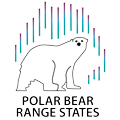Develop a climate change communications plan that outlines key messages (e.g., how climate change effects vary among subpopulations on both temporal and spatial scales, impacts to prey and denning habitat) regarding the threat to the Arctic and to polar bears from climate change and the need for the global community to reduce GHG emissions
Summary of the Action:
At the March 2020 biennial meeting of the Polar Bear Range States held in Norway, it was decided that a circumpolar communications plan that addresses the effects of climate change on polar bear conservation should be developed to help achieve Objective 2 of the CAP on climate change communications. It was decided that an ad hoc working group should be created to draft the plan.
The ad hoc Climate Change Communications Working Group (CCCWG) is composed of Range States representatives as well as invited external experts, including representatives from the scientific advisory body to the RS (the Polar Bear Specialist Group - PBSG) and representatives from non-governmental organizations (NGOs), indigenous rights holders and other relevant organizations that have targeted audiences and strong public reach. The ad hoc working group is time-limited and specific in scope. The main goal of the work is to develop a Climate Change Communications plan that outlines key messages and related communications actions about the impact of climate change on polar bears and their habitats.
Action Lead:
Andreas B. Schei (Norwegian Environment Agency,
Polar Bear Range State Participants:
- Lauren Schmuck (Environment and Climate Change Canada)
- Lindsey Mangipane (U.S. Fish and Wildlife Service)
- Jesper Ødegård Jacobsen (Greenland Ministry of Fisheries, Hunting and Agriculture)
- Karen Lone (Norwegian Environment Agency)
- Stanislav Belikov (Russia)
- Angelina Gnedenko (Russia)
- Droplaug Ólafsdóttir (Polar Bear Agreement, Project Officer)
Duration of action:
2020-2021
Deliverables (output):
-
D1. Climate change communications plan that outlines i) key messages regarding the threats to the Arctic and polar bears from climate change and the need for the global community to reduce GHG emission, ii) how the messages will be delivered and iii) how the message will target different audience groups.
-
D2. Finalized and /or developed drafts of communications products from a face to face meeting based on the outlines in D1.
-
D3. Action plan listing defined communications activities and the responsible Partner organization, based on D1, D2, CCC-A3, CCC-A5, and EH-A7.
-
D4. Recommendations on procedure for implementation of the climate change communication plan, monitoring and evaluation of its progress and impact.
Impact (outcome):
The climate change communications plan that is produced from CCC-A2 will be the main tool that is used by the Range States to convey the impact of climate change on polar bears. The creation of the communications plan will help lay the groundwork for successfully completing all other actions under Objective 2. The vision of the CAP is "to secure the long-term persistence of polar bears in the wild that represents the genetic, behavioral, life-history, and ecological diversity of the species." The CAP also identifies climate change and the associated reductions in the extent and composition of sea ice to be the greatest threat to polar bear persistence. Therefore, work to communicate to the public, policy makers, and legislators around the world the importance of mitigating GHG emissions to polar bear conservation would provide a substantial contribution toward achieving the vision of the CAP.
Dissemination:
Partners will use their existing communication networks to disseminate messages developed through CCC-A2 to the public and policy makers around the world.
